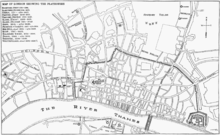Whitefriars Theatre

The Whitefriars Theatre was a theatre in Jacobean London, in existence from 1608 to the 1620s — about which only limited and sometimes contradictory information survives.
Location
The Whitefriars district was outside the medieval city walls of London to the west; it took its name from the priory of
Theatre
In 1608,
The Queen's Revels Children were joined in 1613 by the Lady Elizabeth's Men. The intention may have been for the combined company to use the Whitefriars as its winter playhouse and the Swan Theatre as a summer venue, as the King's Men did with the Blackfriars Theatre and the Globe.[2] But Philip Rosseter, the manager of the Queen's Revels company, lost his lease on the Whitefriars in 1614 and was unable to renew it. The combined company split again, and by October 1614 the Lady Elizabeth's Men were at the newly opened Hope Theatre south of the Thames.
In 1615 the Queen's Revels players moved to Rosseter's short-lived Porter's Hall Theatre and then passed out of existence. After that point, the story of the Whitefriars Theatre grows obscure; Prince Charles's Men may have used the theatre, though they were also acting at the Hope. A 1616 reference pictures the place as poorly furnished and suffering from rain damage. In 1621 the building's then-current landlord, Sir Anthony Ashley, "turned out the players."[3]
Replacement
In 1629 the Whitefriars was replaced by the Salisbury Court Theatre, which was located across Water Lane (now the southern end of Whitefriars St) from the Whitefriars, where the KPMG headquarters now stands. Salisbury Court was named after the medieval house and garden of the Bishops of Salisbury, which stood on the east side of Water Lane.[4] To add an element of posthumous confusion, the Salisbury Court Theatre was sometimes referred to as the Whitefriars in later years, as in the 1660s diary of Samuel Pepys.
The site of the Whitefriars priory is now occupied by the offices of
Notes
- ^ Munro, p. 25.
- ^ R. A. Foakes, "Playhouses and players," in Braunmuller and Hattaway, p. 30.
- ^ Chambers, Vol. 2, pp. 515-17.
- ^ Clapham, p. 17 and fig. facing.
References
- Braunmuller, A. R., and Michael Hattaway, eds. The Cambridge Companion the English Renaissance Drama. Cambridge, Cambridge University Press, 2003.
- Carmelite Priory of London," Journal of the British Archaeological AssociationNew Series 16 part 1 (March 1910), pp. 15–32.
- Chambers, E. K.The Elizabethan Stage. 4 Volumes, Oxford, Clarendon Press, 1923.
- Halliday, F. E. A Shakespeare Companion 1564–1964. Baltimore, Penguin, 1964.
- Munro, Lucy. The Children of the Queen's Revels: A Jacobean Theatre Repertory. Cambridge, Cambridge University Press, 2005.
External links
- Shakespearean Playhouses, by Joseph Quincy Adams, Jr. from Project Gutenberg
